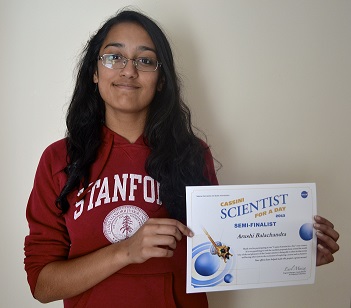Contribute
| Arushi Bhalchandra: A Semi Finalist In Interplanetary Essay Contest |
Press Release
06/04/2014
Arushi Bhalchandra an eighth grade student at RJ Grey Junior High School was named a semi-finalist for the 12th edition (2013) national interplanetary essay contest sponsored by the NASA’s Jet Propulsion Laboratory. The ‘Cassini Scientist for a Day’ contest is designed to give students in grades five through 12 a taste of life as NASA scientist. Arushi examined three possible observations taken by Cassini while orbiting Saturn and chose the one she thought would yield the best scientific results, explaining her reasons in a 500 word essay. More than 2,300 students from 37 states entered the contest, and her article rose to the semi-finals. Arushi is a member of the Young Einstein’s Science Club, where in preparation of the contest, students watched videos about the Cassini mission which has been in orbit around Saturn since 2004; Saturn's moon, Iapetus; Saturn's moon, Dione and about Saturn itself.
Arushi Bhalchandra’s essay
My research shows that Iapetus, which is the third largest moon of Saturn, is the best choice for Cassini to target. Iapetus has a number of intriguing features that are unique through out the entire solar system and so deserves further investigation. These include a perceptible 'two-tone' coloration and the massive equatorial ridge running half way around the equator giving it a shape similar to a walnut. Although the ridge was first discovered when the Cassini spacecraft imaged Iapetus on December 31, 2004, even in 2013 despite several fascinating theories, the scientific explanation for this feature is not completely understood! If we use Cassini to further explore this moon, I’m sure we will solve this mystery and expand our knowledge of the universe. Some people believe that Iapetus is really the “Death Star†from Star Wars built by aliens because of these unexplainable features. Wouldn’t it be amazing if it were really so? The Cassini data will surely enlighten the truth.
Iapetus is a tidally locked to Saturn as is our moon to Earth. It has a unusually low density of 1.09 g/cm³, demonstrating that is consists of little to no solid rock, and is largely made of what scientists believe is watery ice. This is a intriguing since it seems to suggest that Iapetus is substantially hollow and there might be complex structures underneath its surface layer. The leading hemisphere of Iapetus is significantly darker with a reddish hue to it while the trailing hemisphere is extremely bright. More data on Iapetus will enable us to identify the white “powered sugar like†substances that partially coat its surface and to determine why there is such a variation in color.
The darker side of Iapetus called Cassini Regio, is so dark that some astronomers believe that it may be dark matter. This matter could have either been blasted onto Iapetus from another one of Saturn’s moons or was formed by methane eruptions in the core of the planet. This side of Iapetus is barely cratered leading astronomers to conclude that the matter on it is restored regularly, covering up any craters that were formed. The heavily developed craters on the brighter part of Iapetus’ surface could be caused by particles from deep inside Saturn shooting out. The Cassini satellite will let us discern the true origin of the craters and examine Saturn’s particles that otherwise wouldn’t be accessible to us.
The shape of Iapetus is another thing that I would like to learn more about. Theoretical models of Iapetus show that, with its density, Iapetus should be a perfect sphere, but it is almost 5 degrees short of being a sphere!
Last December, French planetary scientists added a new twist to the tale by suggesting that a giant impact with another object slowed Iapetus’ rotation, deformed its crust and caused the mountainous ridge to pinch out from the middle.
All these fascinating theories can be proved only with additional data and that is why I think Iapetus deserves further investigation.
You may also access this article through our web-site http://www.lokvani.com/
